Are you looking for ways to make your brand stand out in the competitive market? Or perhaps you’re struggling to keep customers coming back? Today, consumers are bombarded with endless choices. It’s time to use effective brand engagement tactics—the ones that form a genuine and long-lasting connection with your audience.
Companies with high customer engagement scores experience 50% higher sales and revenue compared to their less-engaged counterparts. This guide gives insights into how you can transform your brand so it resonates deeply with your audience to turn casual buyers into lifelong customers.
Whether you’re a startup founder, a marketing professional, or a business leader, this guide is for you. We’ll give practical and innovative methods with real-life examples that will strengthen your brand identity and loyalty. Let’s explore how brand engagement can boost your reputation, sales, and revenue.
What Is Brand Engagement
Brand engagement is the process by which a brand forms a relationship with its customers. It’s about creating a strong emotional and psychological connection. This concept goes beyond traditional marketing efforts. It focuses on building a deeper, more meaningful interaction with your audience.
Examples Of Brand Engagement
A real-life example of exceptional brand engagement is Starbucks. Starbucks excelled in creating a deep, emotional connection with its customers. by transforming the simple act of buying coffee into a unique, personalized experience.
They held an annual holiday campaign, #RedCupContest, inviting customers to decorate their Starbucks red cups and share photos on social media. This campaign generated massive online engagement and community participation.

Brand Engagement
Similarly, the Starbucks Happy Hour campaign offers discounts at certain hours, announced via mobile app and social media. It increased app downloads and social media engagement. It also increased the Starbucks rewards program’s members to 15.1 million. The best part, this strategy ultimately boosted their sales in the U.S. by 40%.
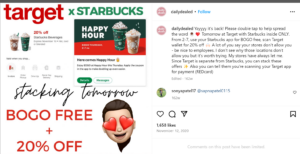
02 Brand Engagement: – Example Of Brand Engagement (Starbucks).png
Why Measure Brand Engagement?
Measuring brand engagement helps businesses with:
I. Emotional Connection
Brand engagement fosters emotional bonds with customers. When customers feel a personal connection to the brand, often because they identify with the brand’s values, message, or community.
II. Interactive Relationship
Unlike one-way communication where brands simply push out marketing messages, brand engagement involves two-way interaction. Customers actively participate and engage in conversations with the brand. You directly gain valuable insights about customer’s preferences.
III. Customer Loyalty & Advocacy
High levels of brand engagement create a loyal customer base. Engaged customers are more likely to make repeat purchases, and recommend the brand to others.
IV. Brand Differentiation
In a crowded marketplace, effective brand engagement can help a brand stand out. By engaging customers in unique and meaningful ways, a brand can differentiate itself from competitors.
V. Long-Term Relationships
Brand engagement focuses on building long-term relationships rather than short-term sales. The goal is to keep customers engaged over time, so they turn into long-term supporters of the brand.
VI. Value Alignment
You can successfully engage customers by aligning your values with their values. This involves social initiatives, strong community involvement, or simply showing a deep understanding of customer’s needs. It boosts your reputation. When customers feel a stronger personal connection, they become more loyal. It also helps you stand out in a competitive market.
8 Effective Ways To Boost Your Brand Engagement Rates
As you go through each strategy, consider how you can apply it to your brand and what tools you will need for it.
A. Understand Your Audience
Conduct thorough market research to grasp the specific needs, preferences, and behaviors of your target demographic. Employ robust data collection methods. These include surveys, social media analytics, and behavior tracking on your website.
Use the collected data to create detailed buyer personas. They are fictional representations of your ideal customers. These personas should guide your marketing strategies, ensuring they resonate with the people you aim to reach. Remember, understanding your audience is not a one-time task. It’s an ongoing learning process and adapting to changing trends and preferences.
B. Deliver Consistent Brand Messaging
Consistency in your brand messaging helps in building brand recognition and trust. Your brand’s voice, tone, and visual elements should be coherent.
This consistency extends to the brand values and story you convey. This ensures that your messaging authentically reflects what your brand stands for. A clear and consistent brand identity helps in forging a stronger, more memorable connection with your audience.
Coca-Cola exemplifies brand consistency with its iconic red-and-white color scheme. Its classic logo is recognized globally. Similarly, their marketing campaigns always emphasize happiness and togetherness. They create a strong emotional connection with their audience by aligning a consistent brand identity across all platforms.
Here’s how you can create a consistent branding:
- Define a brand voice that resonates with your target audience.
- Create a visual style guide for consistent branding (color scheme, font, logo, etc.)
- Document your brand’s core values and story.
- Train all team members on brand messaging.
- Ensure brand consistency across all digital platforms.
- Apply your brand voice in all customer communications.
C. Leverage Social Media Effectively
Post regular, relevant content across social media channels. Whether you create a Facebook page, Twitter, or Instagram, respond to comments, messages, and mentions promptly. This approach fosters a sense of community and shows that you value customer interaction.
Create shareable content to amplify your reach and strengthen your brand presence on social media like:
- Infographics
- Relatable posts
- Engaging videos
- Memes and Humor
- Inspirational Quotes
- Challenges/Contests
- Behind-the-Scenes Content
- Exclusive Offers/Flash Sales
Wendy’s stands out in social media with its unique blend of wit and humor. They engage audiences through playful online banter. This approach, often going viral, breaks away from conventional marketing. It resonates especially with younger demographics. Their strategy, rich in pop culture references, enhances brand visibility and fosters a loyal online community.

03 Brand Engagement – Leverage Social Media
D. Focus On Customer Experience
A positive customer experience will make your customers feel valued and understood. Here are a few expert insights into how you can master it:
- Personalize customer interactions with tailored recommendations.
- Quickly respond to customer inquiries and feedback on all channels.
- Offer multiple, convenient customer support options like chat or phone.
- Regularly update your website and platforms to keep the user experience fresh.
- Keep your website and all customer touchpoints user-friendly and easy to navigate.
E. Utilize Content Marketing
Create and share valuable, relevant, and consistent content to attract and retain your specific audience. Make sure your content is high-quality, informative, and entertaining. This way you can establish your brand as an expert in your industry.
Diversify your content formats into blogs, videos, podcasts, and infographics to keep your content strategy dynamic and engaging. You can hire a marketing intern to assist with these extensive content marketing tasks. This will ensure a steady stream of engaging content, while you save valuable time for broader business initiatives.
Look at how Lanteria, an HR solutions provider is excelling at content marketing. They effectively utilize social media, blog posts, and video content to enhance customer engagement. For example, they post informative content that addresses various HR challenges and trends. This helps to establish themselves as an authority in the HR field.
Their content serves as a resource for their customers.

04 Brand Engagement – Utilize Content Marketing
F. Encourage Customer Feedback
Actively encourage customer feedback whether you’re offering online services, selling digital products, or running an eCommerce platform. Use surveys, social media polls, and direct communication to get feedback. This helps you know what customers need and want from you.
It also identifies areas where your brand can improve.
Customer reviews and ratings are particularly insightful as they directly reflect your audience’s experiences and satisfaction. Remember to always display positive reviews on your website, much like Digestive Warrior does on its homepage. Real customer feedback highlights customer satisfaction and encourages new visitors and sales.
Actively engage with the feedback, both positive and negative, and refine your offers accordingly. Show that you value and act on customer feedback to build trust with your brand.
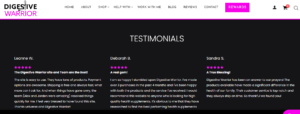
05 Brand Engagement – Customer Feedback
G. Implement A Strong Email Marketing Strategy
Segment your email list for more targeted and personalized communication. This makes your emails more relevant to each recipient. It also maintains a high level of interest and engagement. Make sure that your emails offer value, whether through informative content, exclusive deals, or engaging stories.
Consider, for instance, Airbnb’s email marketing strategy. Airbnb effectively keeps its active users engaged with personalized emails.
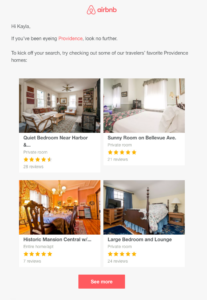
06 Brand Engagement – Email Marketing Strategy
They align email content with individual user preferences like previous searches and bookings. That way, the recipients get relevant and appealing travel suggestions to increase repeat bookings.
Much like Airbnb’s tailored approach, the Sokisahtel eCommerce store uses its emails to send the best special offers and discount deals. Their email marketing focuses on generating more sales through targeted communication.

07 Brand Engagement – Email Marketing Strategy
H. Be Socially Responsible
Today, customers increasingly favor socially responsible brands. Engage in activities that show your commitment to social and environmental issues. This builds a positive brand image.
For example, Lush Cosmetics takes a strong stand against animal testing. Their cruelty-free and ethically sourced products attract customers who prioritize animal welfare and environmental sustainability.
This commitment to ethical practices goes beyond mere branding. It influences product development and customer engagement strategies to build a socially responsible brand image.
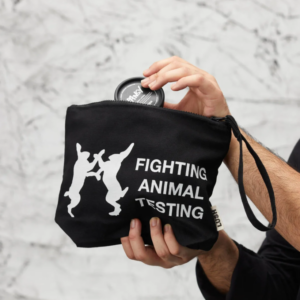
08 Brand Engagement – Socially Responsible
How To Measure Brand Engagement
Measure brand engagement using advanced analytics tools to understand how effective your marketing strategies are. It’ll help you make informed decisions to improve your relationship with your audience.
Here are 7 key methods and metrics to measure brand engagement:
1. Social Media Metrics
1.1. Likes, Shares, Comments
These are the immediate indicators of how your audience is reacting to your content. High engagement on social media posts indicates that your content resonates with your audience.
1.2. Followers Growth
A steady increase in followers can signal growing brand awareness and engagement.
1.3. Social Media Mentions
The frequency of user mentions reflects your brand’s presence and influence. Monitor mentions to gauge public sentiment and the impact of your marketing campaigns.
2. Website Analytics
2.1. Traffic
The total number of visitors indicates the level of interest in your brand. High traffic suggests successful marketing efforts and brand awareness.
2.2. Bounce Rate
This metric measures the percentage of visitors who leave your site after viewing only one page. A lower bounce rate indicates that visitors find your site content relevant and engaging, prompting them to explore further.
2.3. Average Session Duration
This is the time users spend on your site during a session. Longer durations imply that users find your content valuable and engaging.
2.4. Page Views
This counts the number of pages that visitors view. More page views suggest that users are taking the time to explore and engage with your website content.
3. Customer Feedback & Interaction
3.1. Surveys & Feedback Forms
Collect direct feedback to get insights into consumer satisfaction and areas for improvement. This way you’ll understand customer needs and preferences that will guide your future strategies.
3.2. Customer Reviews & Ratings
Regularly monitor and analyze reviews and ratings across various platforms, like Google, Yelp, or eCommerce sites. This will give honest customer perceptions of your products or services.
4. Email Marketing Metrics
4.1. Open Rates
This indicates how many people are opening your emails. High open rates suggest that your email content is appealing and that your subject lines are effective.
4.2. Click-Through Rates (CTR)
This measures how effective your email content is. A high CTR means recipients find your emails valuable enough to engage further by clicking on links.
5. Engagement Through Events
5.1. Event Attendance
The number of people attending your events (webinars, workshops, product launches) is a direct measure of interest and engagement in your brand.
5.2. Interaction During Events
Active audience participation like asking questions or providing feedback strongly indicates an engaged and interested audience.
6. Brand Loyalty Programs
6.1 Participation Rates
Measures how many customers are actively engaged with your loyalty program. It indicates their interest and connection to your brand.
6.2. Redemption Rates
Measure how frequently customers redeem their rewards. It reflects the effectiveness of your loyalty program in maintaining ongoing customer engagement.
7. Net Promoter Score (NPS)
This metric assesses customer loyalty and satisfaction based on one simple question: “How likely are you to recommend our brand to a friend or colleague?” It categorizes customers into Promoters, Passives, and Detractors.
A high NPS indicates that your customers are satisfied and enthusiastic advocates of your brand. It predicts business growth and understands the overall health of customer relationships.
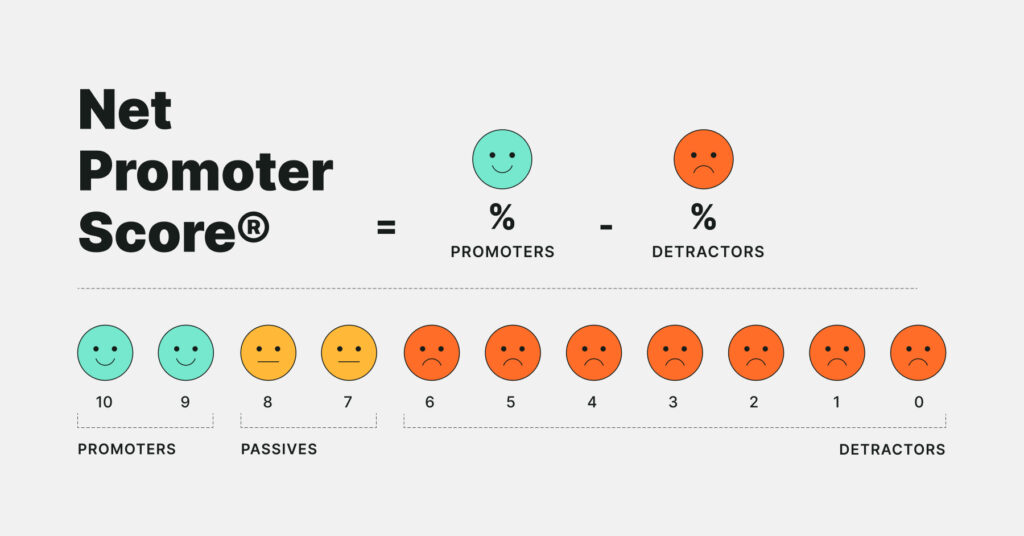
09 Brand Engagement – Net Promoter Score (NPS)
Besides these aspects, understand different types of customer engagement to adjust your strategies accordingly. Brand engagement can be of two types:
- External brand engagement
- Internal brand engagement
External Brand Engagement
External brand engagement refers to how a brand interacts with its customers and the wider public. External engagement strategies are more marketing and communication-focused. It’s about building relationships with people outside the organization and involves:
- Communicating with customers through marketing channels.
- Involving the brand in community initiatives or social causes.
- Ensuring that customers have positive experiences at every touchpoint.
- Shaping how the brand is viewed by the public, including brand image, reputation, and customer loyalty.
Internal Brand Engagement
Internal brand engagement, on the other hand, focuses on the brand’s relationship with its employees. When employees are engaged and believe in the brand, they are more likely to provide better customer service. This positively influences external brand perception. Employee brand engagement strategies are more HR and management-focused. It includes:
- Ensuring employees are satisfied, motivated, and loyal.
- Encouraging employees to become brand ambassadors.
- Building a strong, positive workplace culture that aligns with the brand’s values.
- Effective communication within the organization about the brand’s goals, values, and strategies.
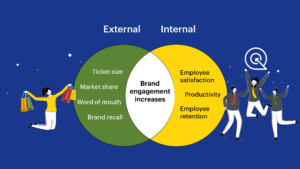
10 Brand Engagement – Internal Brand Engagement vs External Brand Engagement
Brand engagement and customer engagement, though closely related, focus on different aspects of the relationship between a business and its audience. Let’s find out the difference between the two.
Brand Engagement vs Customer Engagement
Brand engagement centers on the emotional and psychological connection with its customers. It’s about how a brand resonates with its audience in terms of values, identity, and the overall experience it offers. This form of engagement is brand-centric. It aims to build a strong brand identity that attracts and retains customer loyalty.
On the other hand, customer engagement is more about the customer’s active participation with the brand. It involves the customer’s actions like making purchases, providing feedback, and engaging with online content. This engagement is customer-centric, focusing on the customer’s journey.
Conclusion
Effective brand engagement strategies connect you with your customers on a deeper, more meaningful level. Apply these methods to boost your brand’s presence and forge stronger bonds with your audience.
Think about how you can integrate these insights into your marketing plan and everyday business practices. What new approach can you adopt today to start enhancing your brand engagement?
For more insights and strategies to boost your brand presence, visit ShortDot, a leading new top-level domain registry. From exploring the latest trends to implementing effective tactics, our blog offers expert guidance to elevate your brand engagement.

Burkhard Berger
Author Bio
Burkhard Berger is the founder of Novum™. He helps innovative B2B companies implement revenue-driven SEO strategies to scale their organic traffic to 1,000,000+ visitors per month. Curious about what your true traffic potential is?
Gravatar: vip@novumhq.com
